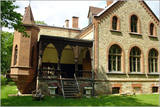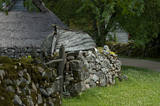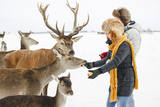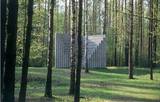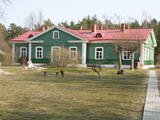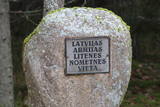| Nr | Nosaukums | Apraksts |
|---|---|---|
|
Zvārtavas pils aicina ceļotājus un dabas draugus, kultūras un mākslas cienītājus iepazīties ar Zvārtavas pili un citiem muižas kultūrvēsturiskiem objektiem, izbaudīt parku un ezeru, izzināt novada vēsturi un apskatīt mākslas darbus, kuri radīti šeit plenēros un rezidencēs, gan LMS muzeja kolekcijas ekspozīcijas un aktuālās izstādes. Skaistā Zvārtavas pils celta 1881.gadā un ir viena no spilgtākajiem neogotikas stila arhitektūras pieminekļiem Latvijā, kas ir valsts nozīmes kultūras piemineklis. Pašlaik pils pieder Latvijas Mākslinieku savienībai, un tieši šis fakts ir pamats pils unikalitātei. Pilī ir saglabājušies neogotikas interjeri, koka kolonas vestibilā, oriģinālās parketa grīdas, mēbeles un stikla kupols ar vitrāžām, caur kurām gaisma dažādos toņos, veido zīmējumus uz sienām un grīdas. |
||
|
Karulas augstienes augstākais reljefa punkts (137 m.vjl.), kas virs tuvākās apkārtnes paceļas par ~ 60 m. Torņa kalnā ir uzbūvēts skatu tornis ar ļoti plašu apkārtskatu. Uz tā platformas ir novietoti panorāmas fotoattēli, kuros atzīmēti zīmīgākie plašākā apkaimē redzamie objekti – apdzīvotas vietas, pilskalni, baznīcu torņi u.c. Turpat izveidota atpūtas vieta un meklējams Rebases ainavu takas sākums. |
||
|
Muhu salas Koguvas ciems ir viens no Igaunijas lauku arhitektūras izcilākajiem paraugiem. Ciems ir diezgan labi saglabājies, un tā lauku ēkas kopā ar akmens žogiem ir iekļautas aizsargājamo arhitektūras pieminekļu sarakstā. Muhu muzejā var iepazīties ar bagātas piekrastes viensētas dzīvi, apciemot Igaunijas rakstnieka Juhana Smūla dzimtās mājas – Tooma sētu, kā arī ieskatīties vecajā ciema skolā un aplūkot tekstila izstrādājumu izstādes eksponātus. |
||
|
Maršruts piemērots laivotājiem, kam nepatīk vienveidība. Latgales ezeri joprojām ir ūdenstūristu mazapgūta teritorija, taču ļoti pievilcīga gan ainavu, gan kultūrvides ziņā. Maršruta informācija no Latvijas Lauku foruma |
||
|
„Barono vila” – paradīzes stūrītis, kurā ir plašs un dziļš zivju dīķis, brieži un dambrieži, kas ganās iežogotos aplokos, aitas, sēņu un ogu bagāti meži, dzidri ezeri un tūristu iecienītie Sventājas upes loki. Viesu nama restorānā tiek pasniegts svaigs, garšīgs un kvalitatīvs ēdiens, izsmalcināti brieža, dambrieža un aitas gaļas ēdieni, krāsnī cepta lietuviešu rudzu maize un uz ugunskura gatavots firmas ēdiens „Barona plovs”. |
||
|
Eiropas centra muzejs. 1991. g. dibinājis Lietuvas tēlnieks Gintaras Karosas. Brīvdabā izstādītas > simts 33 pasaules valstu mākslinieku radītās instalācijas. |
||
|
Veidojās kā nu jau slēgtās Ignalinas AES (6 km attālumā) darbinieku pilsēta ar padomju laikiem izteiktām arhitektoniskām formām un monumentālismu. |
||
|
Mazskarts Salacas upes ielejas posms ar lielu smilšakmens iežu atsegumu, netraucētu alu u.c. biotopu, sugu un ainavu daudzveidību. Salaca ir viena no nozīmīgākajām Baltijas jūras lašupēm un otra populārākā Vidzemes ūdenstūristu upe. Kā galvenie apmeklētāju piesaistes objekti jāmin ģeoloģiskie pieminekļi - Sarkanās klintis, Skaņais kalns, Neļķu klints, Velna ala un kultūras pieminekļi - Lībiešu pilskalns, Vecsalacas muiža, Lībiešu muzejs, Valtenberģu muiža, unikālie Salacas nēģu tači u.c. Parkā atrodas viens no Ziemeļvidzemes populārākajiem tūrisma objektiem – Skaņākalna parks, kurā izveidots blīvs taku tīkls. Salaca ir arī populārs makšķernieku galamērķis. Ietilpst Ziemeļvidzemes biosfēras rezervāta teritorijā. |
||
|
This grand hiking tour includes some of the best and most beautiful parts of the Forest Trail in Latvia and Estonia. Hikes in the forest trails and villages are combined with trips and excursions in cities, as well as other popular tourist sights in both countries. You will get a detailed impression about the forest diversity and most popular national parks in Latvia and Estonia. You will start the tour in Riga, where you will enjoy the beautiful Old Town included in the UNESCO and Art Nouveau District. Then you will drive to Sigulda and see the most scenic ancient valley of the River Gauja, visit Turaida Museum Reserve, hike in Gauja National Park till the historic Ligatne papermill village. Further on you will visit the famous Lake Āraiši Castle, hike on the Cirulisi nature trails and see the beautiful medieval town of Cesis. On the way to Estonia you will stop at the Sietiņiezis big sandstone cliff to have picturesque views of the River Gauja. Then you will stay in Estonia’s second biggest city – Tartu, and visit the recently opened Estonian National Museum. Further on you will drive to Alutaguse National Park and hike along the picturesque Kurtna landscape reserve among the bright coniferous forests ornamented by the mirror surfaces of its many lakes. At the end of the tour you will hike in Estonia’s oldest national park – Lahemaa, which means the “land of bays” in Estonian. The Forest Trail goes along the bays and peninsulas of Lahemaa National Park, introducing the hikers to its most significant natural and cultural heritage. The forests are rich with blueberries and mushrooms in autumn and the air is very clean. This tour will end with sightseeing in Tallinn, Estonia’s capital city, with the Old Town also included in UNESCO. |
||
|
Gara un iztiepta teritorija ap 30 km garumā starp Baltijas jūru un Kolkas – Ventspils ceļu, kas sākas pie Irbes ietekas un beidzas pie Ovišraga. Dibināta g.k. piekrastes biotopu – sauso skujkoku mežu, kangaru un vigu kompleksa (t.sk. mitro starpkāpu ieplaku), pelēko kāpu, kā arī šeit mītošo sugu aizsardzībai. Kangaru – vigu ainava un pelēkās kāpas ir Eiropas mērogā nozīmīgi biotopi. Tūristus šeit piesaista ne tikai smilšainie liedagi un mazapdzīvotās pludmales, bet arī Miķeļbāka, Ovišu bāka (iespēja apskatīt bākas kompleksu un tajā izveidoto muzeju) un Miķeļtorņa luterāņu baznīca. Saglabājies padomju armijas militārais mantojums, kādreizējā šaursliežu dzelzceļa atliekas (uzbērums, staciju vietas, kuru vietā piemiņas akmeņi u.c.), kas šobrīd, diemžēl netiek izmantots kā tūrisma resurss. |
||
|
Maršruts ved gar latviešu likteņupes Daugavas abiem krastiem. Tajā iekļautas tādas nozīmīgas vietas kā Koknese pilsdrupas un topošais Likteņdarzs. Ceļotājus priecēs gan brīnišķīgi upes skati, it īpaši izstaigājot Daugavas loku takas, gan seni pilskalni, latgaļu podniecības tradīcijas un citi amatu meistari. Daugavpils ar savu daudzveidīgo militāri industriālā mantojuma piedāvājumu un slavenā māksliniekka Marka Rotko mākslas centru. Iespēja zirga mugurā izstaigāt Daugavas krastus Baltkrievijas pierobežā. Bebrenē vērts nogaršot bebru dziedzeru uzlējumu, bet Dvietē uzzināt par Latvijas “piekto sezonu” jeb varenajiem plūdiem ik gadu. Maršruta informācija no Latvijas Lauku foruma |
||
|
Spriņģu pilskalns (Golberova gora) atrodas Rēzeknes pilsētas
pievārtē un interesants ar savu īpatnējo veidolu. Valsts nozīmes arheoloģijas
piemineklis.
|
||
|
This tour leads to the popular seaside resort towns in Lithuania and Latvia, from Nida on the Curonian Spit to Jūrmala on the Gulf of Riga. The first stage of the route runs through the Curonian Spit to the city of Klaipėda with its symbol – the wooden sailing ship – and its old town resembling German towns in terms of architecture. You will then visit the Lithuanian summer beach capital Palanga with some of its top sights being the Botanical Park, the Amber Museum, the pedestrian street of J. Basanavičius and the Sea Pier. Next, the route will take you to the former fishermen village of Šventoji, now a resort town, near which the Žemaičių alkas (Samogitian Sanctuary) is located – an ancient pagan sanctuary. After crossing the border of Lithuania/Latvia you will reach Liepāja – known as the windiest city in Latvia. Should you be interested in military heritage, you will find that in the former military port of Karosta. The tour continues to reach Ventspils, another seaside city. Here, you can go on a voyage on a small vessel on the river Venta river and out to the sea, walk along the riverside, go for a ride on the narrow-gauge train called “Mazbānītis”, marvel at greenery in the form of clocks made of flowers, spot the iconic cows of Ventspils – multiple sculptures scattered around the city streets. At the end of the tour, you will drive to Jūrmala and walk on the Baltic Coastal Hiking Route through the longest Latvian resort cities boasting with its widest sandy beaches. |
||
|
Litenes vārds saistās ar vienu no traģiskām Latvijas vēstures lapaspusēm. 20. gs. 20. - 30. gados netālu no tās atradās Latvijas armijas vasaras nometne, kur 1941. g. vasarā pret latviešu virsniekiem tika vērsts komunistiskā režīma terors: gandrīz pustūkstoti latviešu armijas virsnieku aizsūtīja uz Noriļsku Sibīrijā, daļu nošāva un slepus apraka tuvējā mežā. 1941. g. vasaras beigās hitleriskās Vācijas armija te nošāva ap 300 civiliedzīvotājus, g.k. ebrejus. Mūsdienās, godinot bojā gājušo piemiņu, izveidotas atceres un piemiņas vietas. |
||
|
Valkas novadā, Pedelē, atrodas saimniecība "Kalnbundas". Tajā pieejamas izjādes un pārgājieni ar zirgiem, zirgu pajūga noma (ziemā kamanas), gunskura vietas un telšu vietas |
||
|
Celta 18. gs. beigās agrīnā klasicisma stilā kā grāfu Mellīnu dzimtas īpašums. Mākslinieciski vērtīgi K. V. Kalopkas zāles dekorējumi (1792. g.) un krāsnis (19. gs. beigas). Parks. |
||
|
Kafejnīca "Dzirnaviņas" atrodas Rīgas – Liepājas autoceļa (A9) 67. km. Ceļotāju iecienīta pusdienu ieturēšanas vieta. Latviešu virtuve: skābeņu zupa, marinēta siļķe ar biezpienu, „Lauku azaids” (kartupeļi, ola, kūpināta gaļa, marinēts gurķis), cūkgaļas kotletes, Kurzemes strogonovs, sautēti skābi kāposti ar mednieku desiņām, miežu putraimu biezputra ar gaļu, rupjmaizes krēms, maizes zupa ar putukrējumu. |
||
|
Saimniecība specializējas uz dažādu dekoratīvo stādu audzēšanu nelielos apjopmos. Sezonas laikā pieejamas arī svaigas krūmmellenes, smiltsērkšķi, cidonijas, augļi un ogas. |
||
|
Arī 18. novembra laukums. Tas sācis veidoties 18. gadsimtā kā tirgus laukums. Tā dominantes bija 1752. g. celtais rātsnams (nav saglabājies) un aptieka, kas šajā ēkā darbojas no 1810. g. līdz pat mūsdienām. 2010. gadā laukumā izveidota strūklaka, kam ir pilsētas ģerboņa forma. |
||
|
Ārstniecības un garšaugu dārzs, apskates un degustācijas programmas. Maizes, piparkūku cepšanas programmas. Piena ceļa programma. Tradicionālā siera gatavošanas programma. Papildus praktiskajām lietām, iespējams iepazīties arī ar muzejā esošajiem darba rīkiem un sadzīves priekšmetiem, kas saistīti ar konkrēto tēmu. Plašas tradicionālās kultūras zināšanas. |
||
